Project Management Report: Methodologies and Project Life Cycle
VerifiedAdded on 2021/04/21
|8
|1517
|62
Report
AI Summary
This report delves into the realm of project management, defining the core practices of initiating, planning, executing, controlling, and closing projects to achieve specific goals within defined timelines. It begins by outlining various project methodologies, including Agile, Waterfall, and PRINCE2, highlighting their roles in guiding project managers through decision-making, problem-solving, and the implementation of project objectives. The report then provides a detailed comparison between the Project Management Body of Knowledge (PMBOK) and the PRINCE2 methodology, contrasting their approaches to project management, decision-making processes, and stakeholder involvement. Furthermore, it explores the relationship between the PRINCE2 methodology and the project life cycle, emphasizing the six core processes and the supporting planning and directing processes. The report concludes by underscoring the importance of selecting the appropriate project management methodology for successful project outcomes, considering the strengths and weaknesses of each approach, and emphasizing the three main stages: planning, implementation, and analysis.
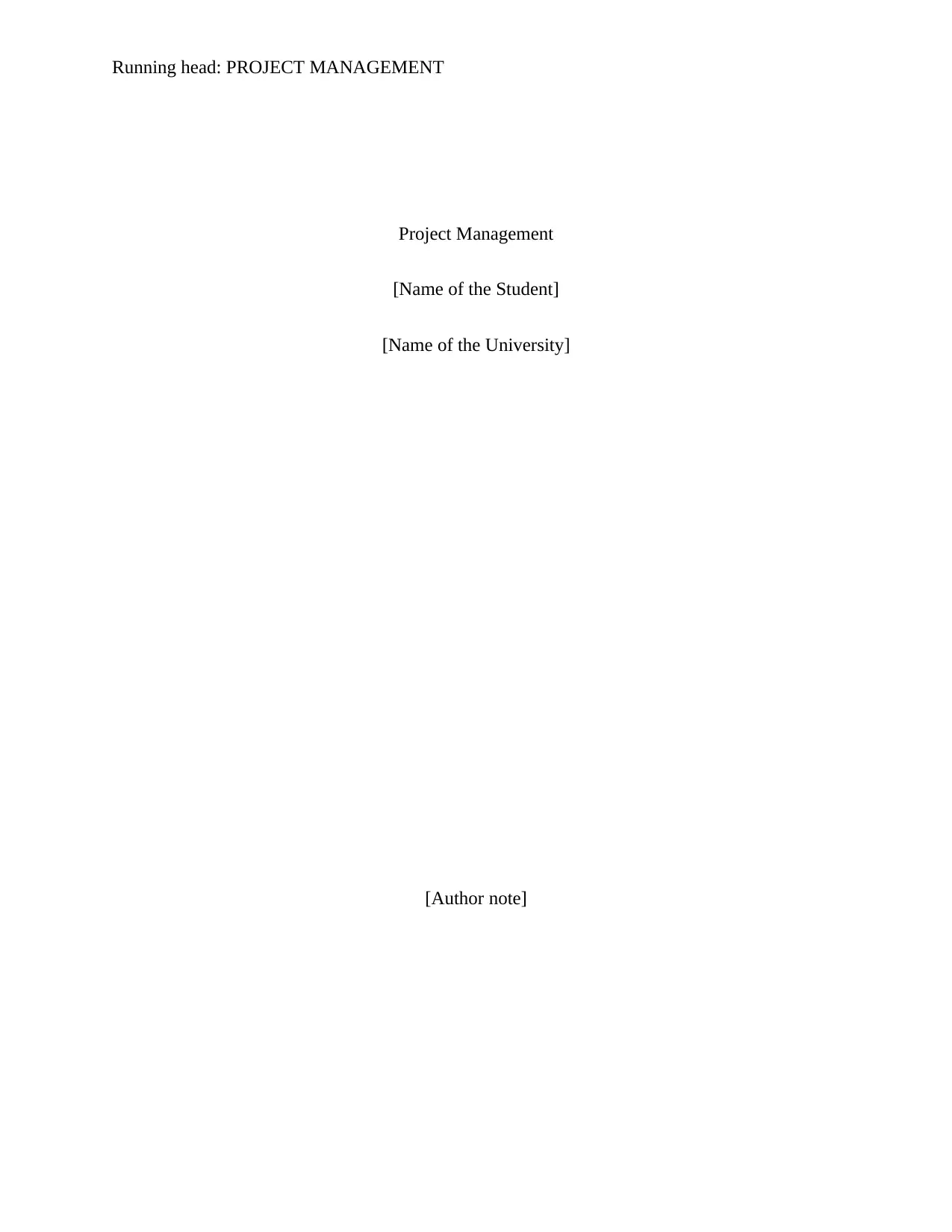
Running head: PROJECT MANAGEMENT
Project Management
[Name of the Student]
[Name of the University]
[Author note]
Project Management
[Name of the Student]
[Name of the University]
[Author note]
Paraphrase This Document
Need a fresh take? Get an instant paraphrase of this document with our AI Paraphraser

1PROJECT MANAGEMENT
Table of Contents
Introduction:....................................................................................................................................2
Discussion:.......................................................................................................................................2
Project Methodology...................................................................................................................2
Role played by project methodology in project management:....................................................3
Comparison of Project Management Body of Knowledge (PMBOK) with PRINCE2
methodology................................................................................................................................3
Relation of PRINCE2 Methodology with Project Life Cycle.....................................................5
Conclusion:......................................................................................................................................6
References:......................................................................................................................................7
Table of Contents
Introduction:....................................................................................................................................2
Discussion:.......................................................................................................................................2
Project Methodology...................................................................................................................2
Role played by project methodology in project management:....................................................3
Comparison of Project Management Body of Knowledge (PMBOK) with PRINCE2
methodology................................................................................................................................3
Relation of PRINCE2 Methodology with Project Life Cycle.....................................................5
Conclusion:......................................................................................................................................6
References:......................................................................................................................................7
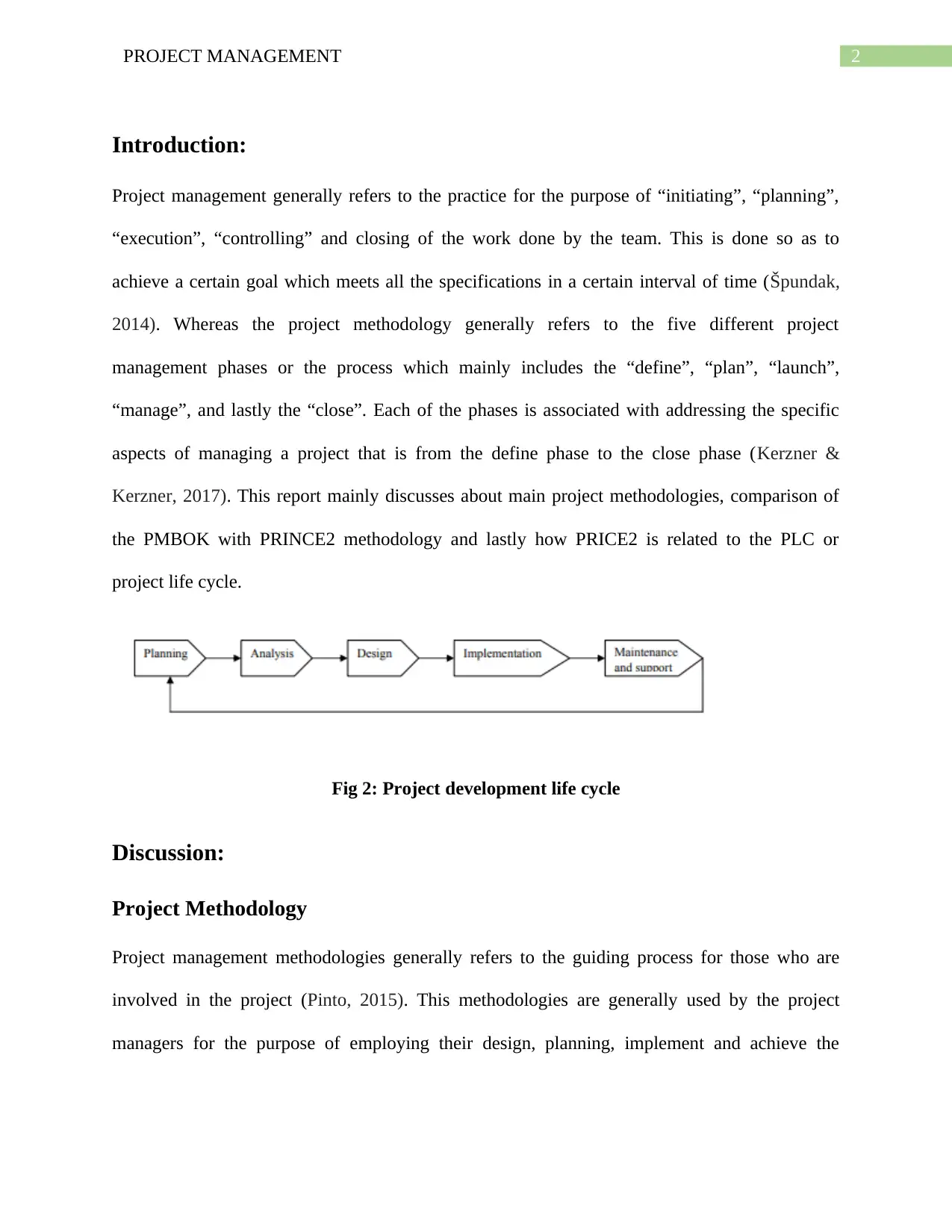
2PROJECT MANAGEMENT
Introduction:
Project management generally refers to the practice for the purpose of “initiating”, “planning”,
“execution”, “controlling” and closing of the work done by the team. This is done so as to
achieve a certain goal which meets all the specifications in a certain interval of time (Špundak,
2014). Whereas the project methodology generally refers to the five different project
management phases or the process which mainly includes the “define”, “plan”, “launch”,
“manage”, and lastly the “close”. Each of the phases is associated with addressing the specific
aspects of managing a project that is from the define phase to the close phase (Kerzner &
Kerzner, 2017). This report mainly discusses about main project methodologies, comparison of
the PMBOK with PRINCE2 methodology and lastly how PRICE2 is related to the PLC or
project life cycle.
Fig 2: Project development life cycle
Discussion:
Project Methodology
Project management methodologies generally refers to the guiding process for those who are
involved in the project (Pinto, 2015). This methodologies are generally used by the project
managers for the purpose of employing their design, planning, implement and achieve the
Introduction:
Project management generally refers to the practice for the purpose of “initiating”, “planning”,
“execution”, “controlling” and closing of the work done by the team. This is done so as to
achieve a certain goal which meets all the specifications in a certain interval of time (Špundak,
2014). Whereas the project methodology generally refers to the five different project
management phases or the process which mainly includes the “define”, “plan”, “launch”,
“manage”, and lastly the “close”. Each of the phases is associated with addressing the specific
aspects of managing a project that is from the define phase to the close phase (Kerzner &
Kerzner, 2017). This report mainly discusses about main project methodologies, comparison of
the PMBOK with PRINCE2 methodology and lastly how PRICE2 is related to the PLC or
project life cycle.
Fig 2: Project development life cycle
Discussion:
Project Methodology
Project management methodologies generally refers to the guiding process for those who are
involved in the project (Pinto, 2015). This methodologies are generally used by the project
managers for the purpose of employing their design, planning, implement and achieve the
⊘ This is a preview!⊘
Do you want full access?
Subscribe today to unlock all pages.

Trusted by 1+ million students worldwide
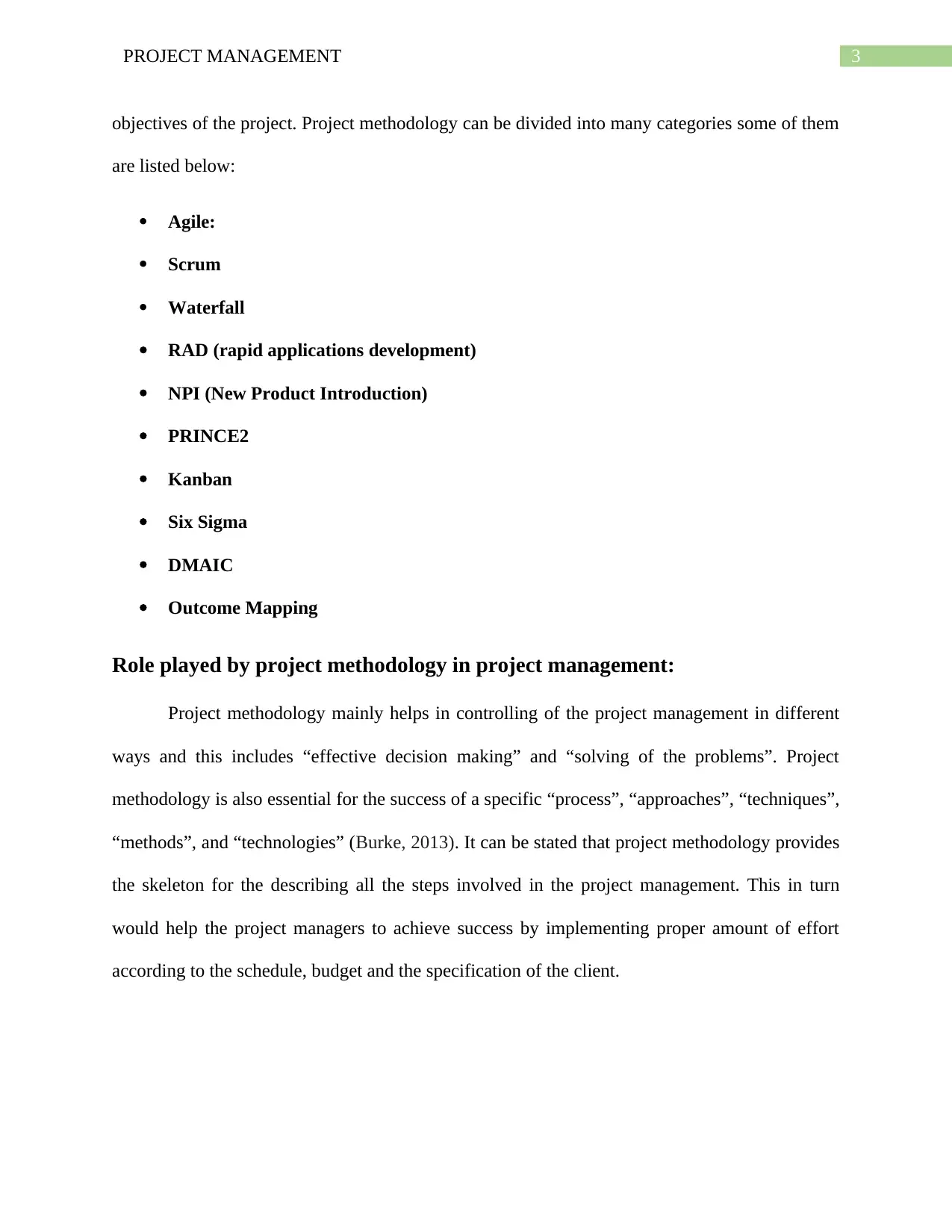
3PROJECT MANAGEMENT
objectives of the project. Project methodology can be divided into many categories some of them
are listed below:
Agile:
Scrum
Waterfall
RAD (rapid applications development)
NPI (New Product Introduction)
PRINCE2
Kanban
Six Sigma
DMAIC
Outcome Mapping
Role played by project methodology in project management:
Project methodology mainly helps in controlling of the project management in different
ways and this includes “effective decision making” and “solving of the problems”. Project
methodology is also essential for the success of a specific “process”, “approaches”, “techniques”,
“methods”, and “technologies” (Burke, 2013). It can be stated that project methodology provides
the skeleton for the describing all the steps involved in the project management. This in turn
would help the project managers to achieve success by implementing proper amount of effort
according to the schedule, budget and the specification of the client.
objectives of the project. Project methodology can be divided into many categories some of them
are listed below:
Agile:
Scrum
Waterfall
RAD (rapid applications development)
NPI (New Product Introduction)
PRINCE2
Kanban
Six Sigma
DMAIC
Outcome Mapping
Role played by project methodology in project management:
Project methodology mainly helps in controlling of the project management in different
ways and this includes “effective decision making” and “solving of the problems”. Project
methodology is also essential for the success of a specific “process”, “approaches”, “techniques”,
“methods”, and “technologies” (Burke, 2013). It can be stated that project methodology provides
the skeleton for the describing all the steps involved in the project management. This in turn
would help the project managers to achieve success by implementing proper amount of effort
according to the schedule, budget and the specification of the client.
Paraphrase This Document
Need a fresh take? Get an instant paraphrase of this document with our AI Paraphraser
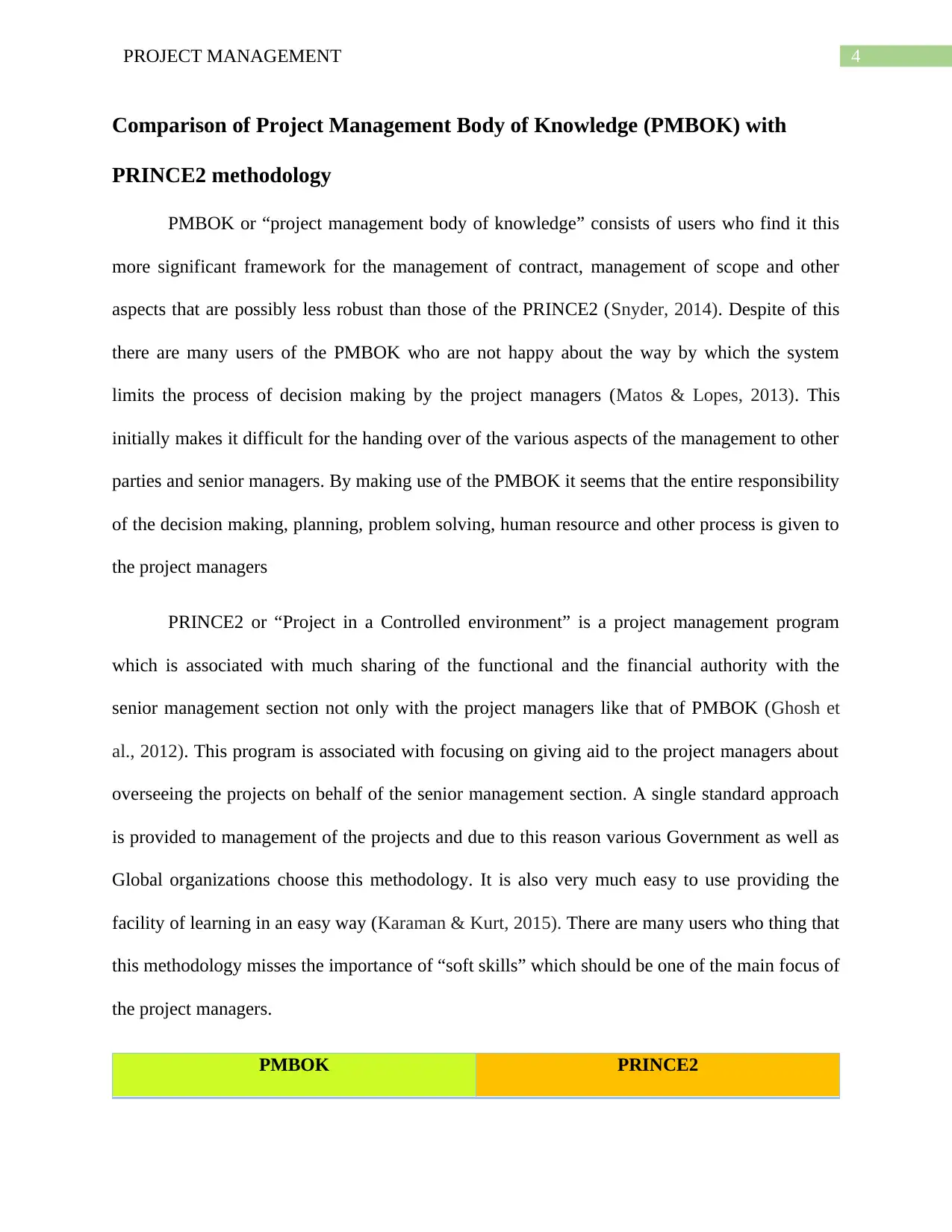
4PROJECT MANAGEMENT
Comparison of Project Management Body of Knowledge (PMBOK) with
PRINCE2 methodology
PMBOK or “project management body of knowledge” consists of users who find it this
more significant framework for the management of contract, management of scope and other
aspects that are possibly less robust than those of the PRINCE2 (Snyder, 2014). Despite of this
there are many users of the PMBOK who are not happy about the way by which the system
limits the process of decision making by the project managers (Matos & Lopes, 2013). This
initially makes it difficult for the handing over of the various aspects of the management to other
parties and senior managers. By making use of the PMBOK it seems that the entire responsibility
of the decision making, planning, problem solving, human resource and other process is given to
the project managers
PRINCE2 or “Project in a Controlled environment” is a project management program
which is associated with much sharing of the functional and the financial authority with the
senior management section not only with the project managers like that of PMBOK (Ghosh et
al., 2012). This program is associated with focusing on giving aid to the project managers about
overseeing the projects on behalf of the senior management section. A single standard approach
is provided to management of the projects and due to this reason various Government as well as
Global organizations choose this methodology. It is also very much easy to use providing the
facility of learning in an easy way (Karaman & Kurt, 2015). There are many users who thing that
this methodology misses the importance of “soft skills” which should be one of the main focus of
the project managers.
PMBOK PRINCE2
Comparison of Project Management Body of Knowledge (PMBOK) with
PRINCE2 methodology
PMBOK or “project management body of knowledge” consists of users who find it this
more significant framework for the management of contract, management of scope and other
aspects that are possibly less robust than those of the PRINCE2 (Snyder, 2014). Despite of this
there are many users of the PMBOK who are not happy about the way by which the system
limits the process of decision making by the project managers (Matos & Lopes, 2013). This
initially makes it difficult for the handing over of the various aspects of the management to other
parties and senior managers. By making use of the PMBOK it seems that the entire responsibility
of the decision making, planning, problem solving, human resource and other process is given to
the project managers
PRINCE2 or “Project in a Controlled environment” is a project management program
which is associated with much sharing of the functional and the financial authority with the
senior management section not only with the project managers like that of PMBOK (Ghosh et
al., 2012). This program is associated with focusing on giving aid to the project managers about
overseeing the projects on behalf of the senior management section. A single standard approach
is provided to management of the projects and due to this reason various Government as well as
Global organizations choose this methodology. It is also very much easy to use providing the
facility of learning in an easy way (Karaman & Kurt, 2015). There are many users who thing that
this methodology misses the importance of “soft skills” which should be one of the main focus of
the project managers.
PMBOK PRINCE2
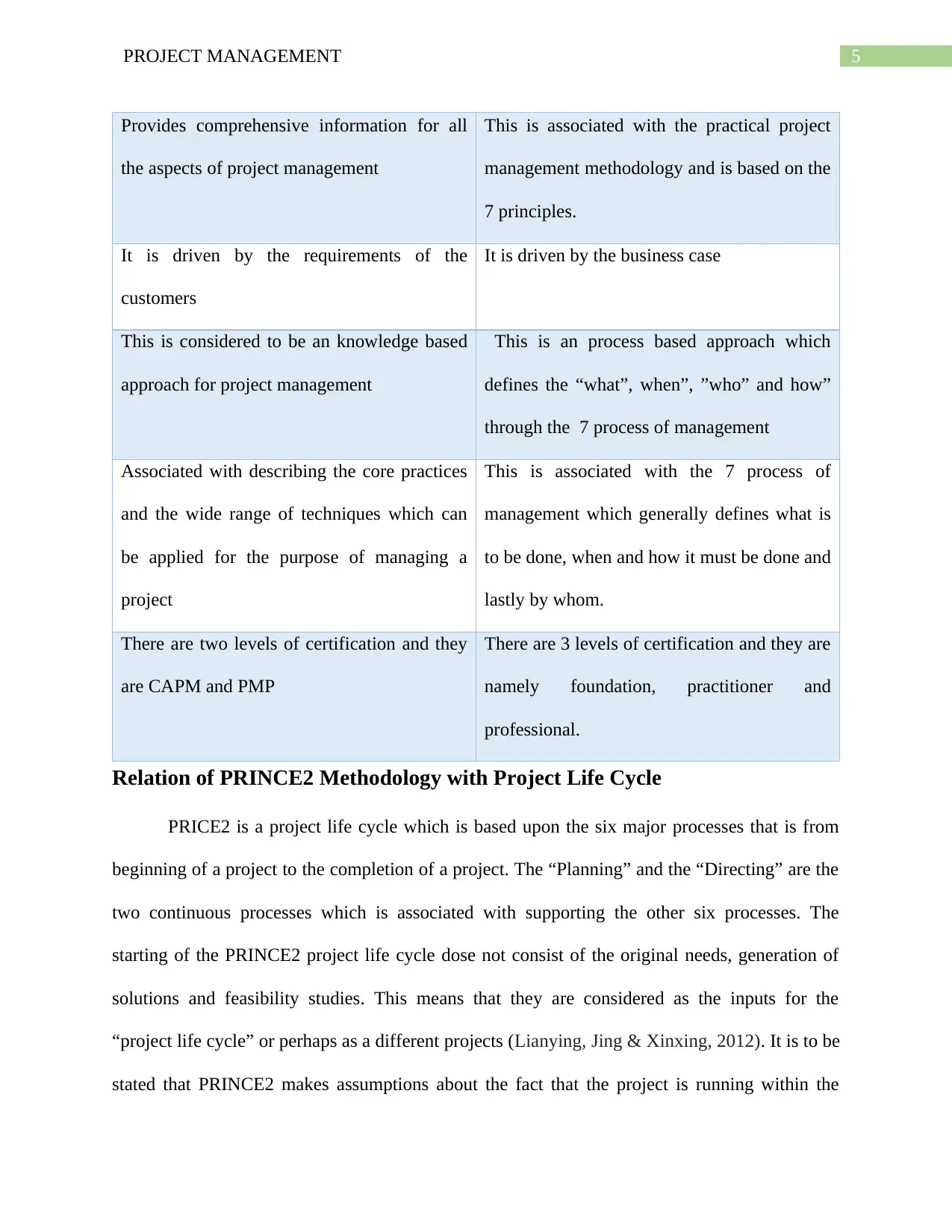
5PROJECT MANAGEMENT
Provides comprehensive information for all
the aspects of project management
This is associated with the practical project
management methodology and is based on the
7 principles.
It is driven by the requirements of the
customers
It is driven by the business case
This is considered to be an knowledge based
approach for project management
This is an process based approach which
defines the “what”, when”, ”who” and how”
through the 7 process of management
Associated with describing the core practices
and the wide range of techniques which can
be applied for the purpose of managing a
project
This is associated with the 7 process of
management which generally defines what is
to be done, when and how it must be done and
lastly by whom.
There are two levels of certification and they
are CAPM and PMP
There are 3 levels of certification and they are
namely foundation, practitioner and
professional.
Relation of PRINCE2 Methodology with Project Life Cycle
PRICE2 is a project life cycle which is based upon the six major processes that is from
beginning of a project to the completion of a project. The “Planning” and the “Directing” are the
two continuous processes which is associated with supporting the other six processes. The
starting of the PRINCE2 project life cycle dose not consist of the original needs, generation of
solutions and feasibility studies. This means that they are considered as the inputs for the
“project life cycle” or perhaps as a different projects (Lianying, Jing & Xinxing, 2012). It is to be
stated that PRINCE2 makes assumptions about the fact that the project is running within the
Provides comprehensive information for all
the aspects of project management
This is associated with the practical project
management methodology and is based on the
7 principles.
It is driven by the requirements of the
customers
It is driven by the business case
This is considered to be an knowledge based
approach for project management
This is an process based approach which
defines the “what”, when”, ”who” and how”
through the 7 process of management
Associated with describing the core practices
and the wide range of techniques which can
be applied for the purpose of managing a
project
This is associated with the 7 process of
management which generally defines what is
to be done, when and how it must be done and
lastly by whom.
There are two levels of certification and they
are CAPM and PMP
There are 3 levels of certification and they are
namely foundation, practitioner and
professional.
Relation of PRINCE2 Methodology with Project Life Cycle
PRICE2 is a project life cycle which is based upon the six major processes that is from
beginning of a project to the completion of a project. The “Planning” and the “Directing” are the
two continuous processes which is associated with supporting the other six processes. The
starting of the PRINCE2 project life cycle dose not consist of the original needs, generation of
solutions and feasibility studies. This means that they are considered as the inputs for the
“project life cycle” or perhaps as a different projects (Lianying, Jing & Xinxing, 2012). It is to be
stated that PRINCE2 makes assumptions about the fact that the project is running within the
⊘ This is a preview!⊘
Do you want full access?
Subscribe today to unlock all pages.

Trusted by 1+ million students worldwide
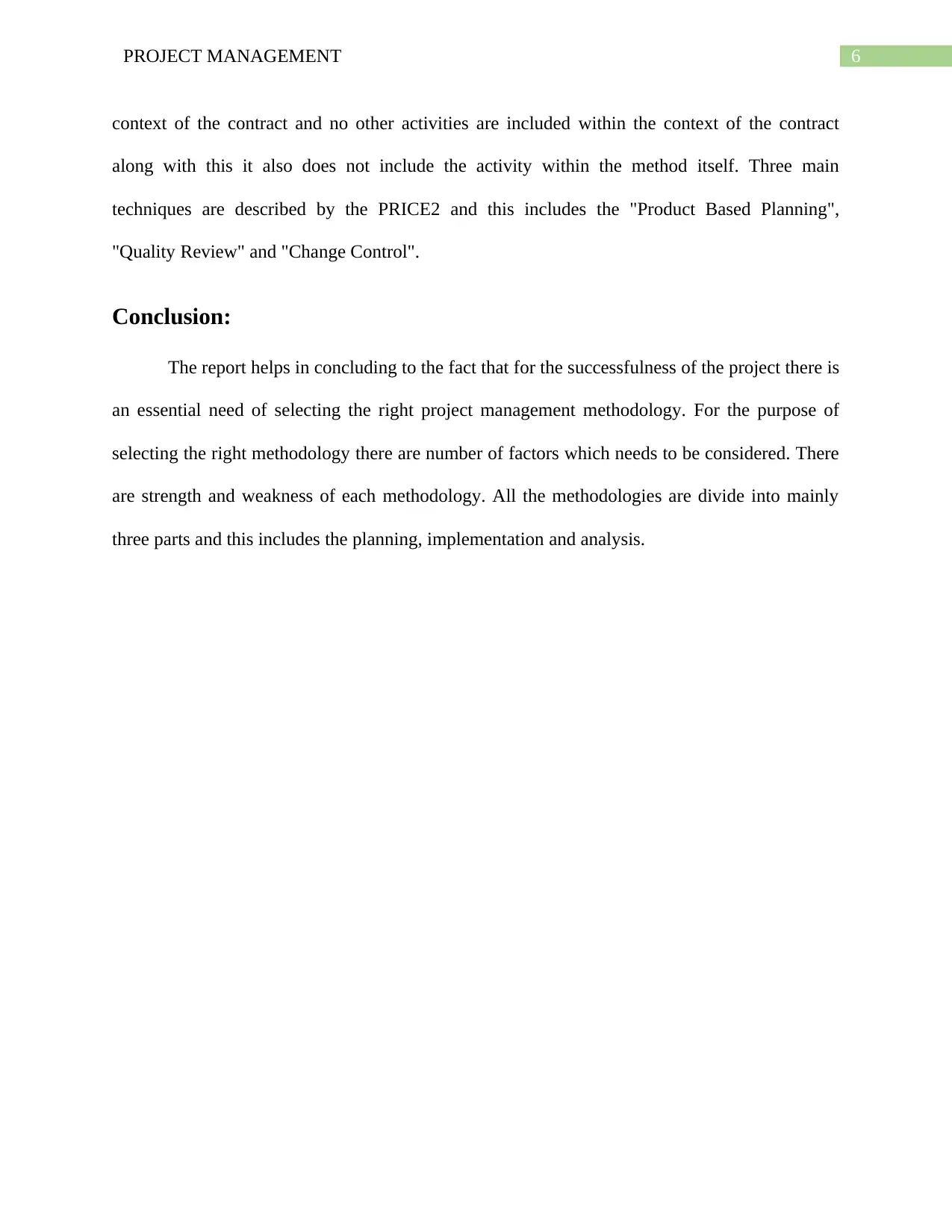
6PROJECT MANAGEMENT
context of the contract and no other activities are included within the context of the contract
along with this it also does not include the activity within the method itself. Three main
techniques are described by the PRICE2 and this includes the "Product Based Planning",
"Quality Review" and "Change Control".
Conclusion:
The report helps in concluding to the fact that for the successfulness of the project there is
an essential need of selecting the right project management methodology. For the purpose of
selecting the right methodology there are number of factors which needs to be considered. There
are strength and weakness of each methodology. All the methodologies are divide into mainly
three parts and this includes the planning, implementation and analysis.
context of the contract and no other activities are included within the context of the contract
along with this it also does not include the activity within the method itself. Three main
techniques are described by the PRICE2 and this includes the "Product Based Planning",
"Quality Review" and "Change Control".
Conclusion:
The report helps in concluding to the fact that for the successfulness of the project there is
an essential need of selecting the right project management methodology. For the purpose of
selecting the right methodology there are number of factors which needs to be considered. There
are strength and weakness of each methodology. All the methodologies are divide into mainly
three parts and this includes the planning, implementation and analysis.
Paraphrase This Document
Need a fresh take? Get an instant paraphrase of this document with our AI Paraphraser

7PROJECT MANAGEMENT
References:
Burke, R. (2013). Project management: planning and control techniques. New Jersey, USA.
Ghosh, S., Forrest, D., DiNetta, T., Wolfe, B., & Lambert, D. C. (2012). Enhance PMBOK® by
comparing it with P2M, ICB, PRINCE2, APM and Scrum project management
standards. PM World Today, 14(1), 1-77.
Karaman, E., & Kurt, M. (2015). Comparison of project management methodologies: prince 2
versus PMBOK for it projects. Int. Journal of Applied Sciences and Engineering
Research, 4(5), 657-664.
Kerzner, H., & Kerzner, H. R. (2017). Project management: a systems approach to planning,
scheduling, and controlling. John Wiley & Sons.
Lianying, Z., Jing, H., & Xinxing, Z. (2012). The project management maturity model and
application based on PRINCE2. Procedia Engineering, 29, 3691-3697.
Matos, S., & Lopes, E. (2013). Prince2 or PMBOK–a question of choice. Procedia
Technology, 9, 787-794.
Pinto, J. K. (2015). Project management: achieving competitive advantage. Prentice Hall.
Snyder, C. S. (2014). A guide to the project management body of knowledge: PMBOK (®)
guide. Project Management Institute: Newtown Square, PA, USA.
Špundak, M. (2014). Mixed agile/traditional project management methodology–reality or
illusion?. Procedia-Social and Behavioral Sciences, 119, 939-948.
References:
Burke, R. (2013). Project management: planning and control techniques. New Jersey, USA.
Ghosh, S., Forrest, D., DiNetta, T., Wolfe, B., & Lambert, D. C. (2012). Enhance PMBOK® by
comparing it with P2M, ICB, PRINCE2, APM and Scrum project management
standards. PM World Today, 14(1), 1-77.
Karaman, E., & Kurt, M. (2015). Comparison of project management methodologies: prince 2
versus PMBOK for it projects. Int. Journal of Applied Sciences and Engineering
Research, 4(5), 657-664.
Kerzner, H., & Kerzner, H. R. (2017). Project management: a systems approach to planning,
scheduling, and controlling. John Wiley & Sons.
Lianying, Z., Jing, H., & Xinxing, Z. (2012). The project management maturity model and
application based on PRINCE2. Procedia Engineering, 29, 3691-3697.
Matos, S., & Lopes, E. (2013). Prince2 or PMBOK–a question of choice. Procedia
Technology, 9, 787-794.
Pinto, J. K. (2015). Project management: achieving competitive advantage. Prentice Hall.
Snyder, C. S. (2014). A guide to the project management body of knowledge: PMBOK (®)
guide. Project Management Institute: Newtown Square, PA, USA.
Špundak, M. (2014). Mixed agile/traditional project management methodology–reality or
illusion?. Procedia-Social and Behavioral Sciences, 119, 939-948.
1 out of 8
Related Documents
Your All-in-One AI-Powered Toolkit for Academic Success.
+13062052269
info@desklib.com
Available 24*7 on WhatsApp / Email
![[object Object]](/_next/static/media/star-bottom.7253800d.svg)
Unlock your academic potential
Copyright © 2020–2025 A2Z Services. All Rights Reserved. Developed and managed by ZUCOL.



